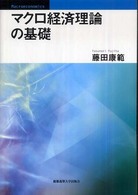- ホーム
- > 洋書
- > 英文書
- > Science / Mathematics
Full Description
Energy efficiency is an integral part of making buildings greener, which has become a key issue for both developing and developed countries. Scholars, researchers, and practitioners from a number of interconnected disciplines have all shown increasing interest in the topic, and studies into buildings' energy performance and cutting-edge measures to achieve government-steered commitments to reduce global greenhouse gas emissions over the coming decades have proliferated.
Net Zero Transition in Buildings is a timely, up-to-date reference resource on design, operation, and management of technology-enhanced equipment and advanced strategies that put guidance and attention toward sustainably responsible energy use within and around buildings at their core. The volume's contents have been subdivided into sections, additionally proffering a deliberately structured flow throughout all chapters which is aimed at quickly getting readers at all levels up to speed or providing them with answers to key questions. Part I discusses physical solutions, namely different types of devices that harness renewable energy resources, store energy, or combine cooling, heating, and power systems; part II covers digital tools (e.g., AI, blockchain, big data, IoT, and digital twins) that can aid with carbon emissions' accounting, predicting and optimizing energy consumption patterns, and more; and part III investigates the very latest technical concepts and approaches for energy self-producing built environment assets and a variety of integrated best practices for the construction sector as a whole. Furthermore, as the net zero transition in this context is a concept that has multidimensional pillars, part IV concludes this sought-after knowledge compilation by making it more comprehensive, well-rounded, and useful for audiences in academia and industry alike.
Contents
1. Introduction to Net Zero transition within the built environment
Part I: Physical Solutions
2. Advancements and Trends in Heat Pump Technology for Net Zero Energy Buildings
3. Typical advanced energy storage technologies for zero-carbon buildings
4. Adsorption vacuum dehumidification for low-carbon indoor environment
5. Liquid-flow window in net-zero buildings
6. Zero-Energy Human Habitat: Survive from Earth to Mars
7. Integrating Solar and Wind Power in Buildings: Concepts and Methods with Practical Applications
8. Enhancing Energy Efficiency in Buildings Using IoT Sensors: A Pathway to Net-Zero Transition
9. Green roof in combating urban heat: A thematic review of heat mitigation mechanism, potential evaluation and influencing factors
Part II: Digital technologies
10. A Sequential GA-Based Optimization for NZEB Clusters to Minimize Low-Voltage Distribution Network Overvoltage Risks
11. Computer vision to advance the sensing and control of Net Zero Transition in Buildings
12. Machine learning for data driven intelligence towards Net Zero Buildings
13. Integrating Blockchain Technology for Advancing Low-Carbon Building Solutions
Part III: Emerging Concepts and Approaches
14. BIM-Driven Whole Lifecycle Assessment: A Pathway to Net Zero Design
15. Integrated Demand and Supply-Side Management: A Review of Concepts and Case Studies
16. Plus Energy Building: definition and technology solutions
17. Exploring Positive Energy Block Potentials: A Parametric Analysis Approach
18. Navigating Policy Challenges in Peer-to-Peer Energy Trading
19. An agenda for the UAE Net Zero Transition in Buildings
20. Conclusions








